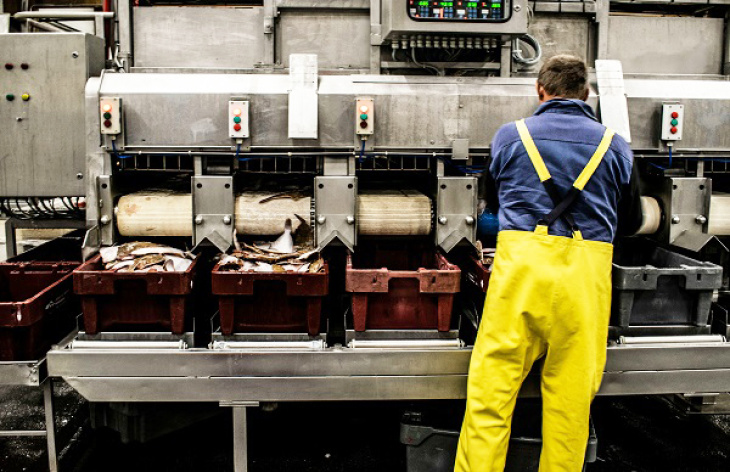Trawls and Climate change
Fishing trawls cause significant CO2 emissions as they stir up the carbon bound in the seabed and release it again. It is also clear that they drastically affect ecosystems in the ocean. A new study by the Helmholtz-Zentrum Hereon models the influence of bottom trawls on sedimentary carbon in the North Sea. It also shows that restrictions on fishing in certain areas would benefit life in the ocean and on land.

The catch from deep-sea fishing goes into mass processing. Photo: Paul Einerhand via Unsplash
What would happen if bottom trawling were banned in all currently designated marine protected areas? In the North Sea, trawls cause CO2 emissions in the order of one million tons to be released into the atmosphere every year by stirring up organically bound carbon. "This is a conservative estimate compared to other studies and corresponds to the emissions from the diesel engines of the fishing fleet itself," says coastal researcher and lead author Lucas Porz from the Institute of Coastal Systems - Analysis and Modeling at Hereon. Current marine protected areas have little positive impact on carbon storage. But by designating "carbon protection zones", both sedimentary carbon and habitats could be effectively protected.
Some areas are particularly sensitive to fishing pressure, such as the Skagerrak between the north coast of Jutland, the south coast of Norway and the northern west coast of Sweden. And also parts of the German Bight. These are mainly areas that have a high proportion of mud in the sediment and are biologically productive, for example due to strong microalgae growth. Bottom trawling is the most important direct human intervention in the carbon budget of the oceans. As there are only a few studies on the subject, some of which are highly controversial, the Hereon study fills a gap. It aims to provide a realistic assessment in order to advance the debate. Until now, experimental studies have been limited to local effects. However, Hereon has now been able to extend these to the entire North Sea and estimate the large-scale effect for the first time. In particular, the redistribution of the resuspended carbon by currents has not been taken into account so far, although this has a major influence on the overall impact and therefore on the climate.
Methodical approach
Porz and his team first reviewed all available data and studies on fishing activity in the North Sea and its impact on sediments and bottom-dwelling animals such as shrimps and mussels. These effects were incorporated into computer models that simulate the distribution of animals, sediments and organic carbon and their interaction with ocean currents. By comparing the simulations with and without bottom trawling, the researchers were able to estimate the impact. In order to investigate the effects of possible management measures, they redistributed the fishing activity in the model from potential closure zones to surrounding areas.
Consequences and recommendations for action
The most effective way to reduce additional emissions would be for fisheries to avoid clearly identified carbon-rich muddy grounds. There are also alternative fishing methods and gear that have a significantly lower impact on the seabed and the animals that live there.
"Bottom trawling in the North Sea has been practiced intensively for more than 100 years and it is therefore difficult to say how exactly the ecosystem is already being changed by it," adds Porz. Whether, for example, there could also be positive ecosystem effects from bottom trawling, such as increased availability of nutrients in the water column, is currently being investigated at Hereon. However, it is known that around a fifth of seabed dwellers do not survive contact with a bottom trawl. According to his study, there would be around 14 percent more animals on the seabed of the North Sea without bottom trawling. In addition, the habitats are altered by the fishing gear. Muddy beds are more affected than sandy beds, as the fishing gear penetrates deeper into muddy beds and they take longer to recover. The composition of the communities living on the seabed also changes.
To date, the ecosystem service of carbon storage has not been taken into account in the designation of marine protected areas. There are signs that this could change, for example with the German government's "Aktionsprogramm Natürlicher Klimaschutz" ("Action Program for Natural Climate Protection”, ANK), which implements funding measures to strengthen the climate protection services of ecosystems. "Even there, seabed sediments still play a subordinate role, although we believe that they represent a more effective and longer-term carbon sink than peatlands or forests, for example," says Lucas Porz.
Further Information
Original publication News Project APOC Website Hereon Institute of Coastal Systems – Analysis and Modeling
Contact
Scientist
Helmholtz-Zentrum Hereon | Institute of Coastal Systems – Analysis and Modeling
Phone: +49 (0) 4152 87-1807
Press Officer
Helmholtz-Zentrum Hereon | Communication and Media
Phone: +49 (0) 4152 87-1648
